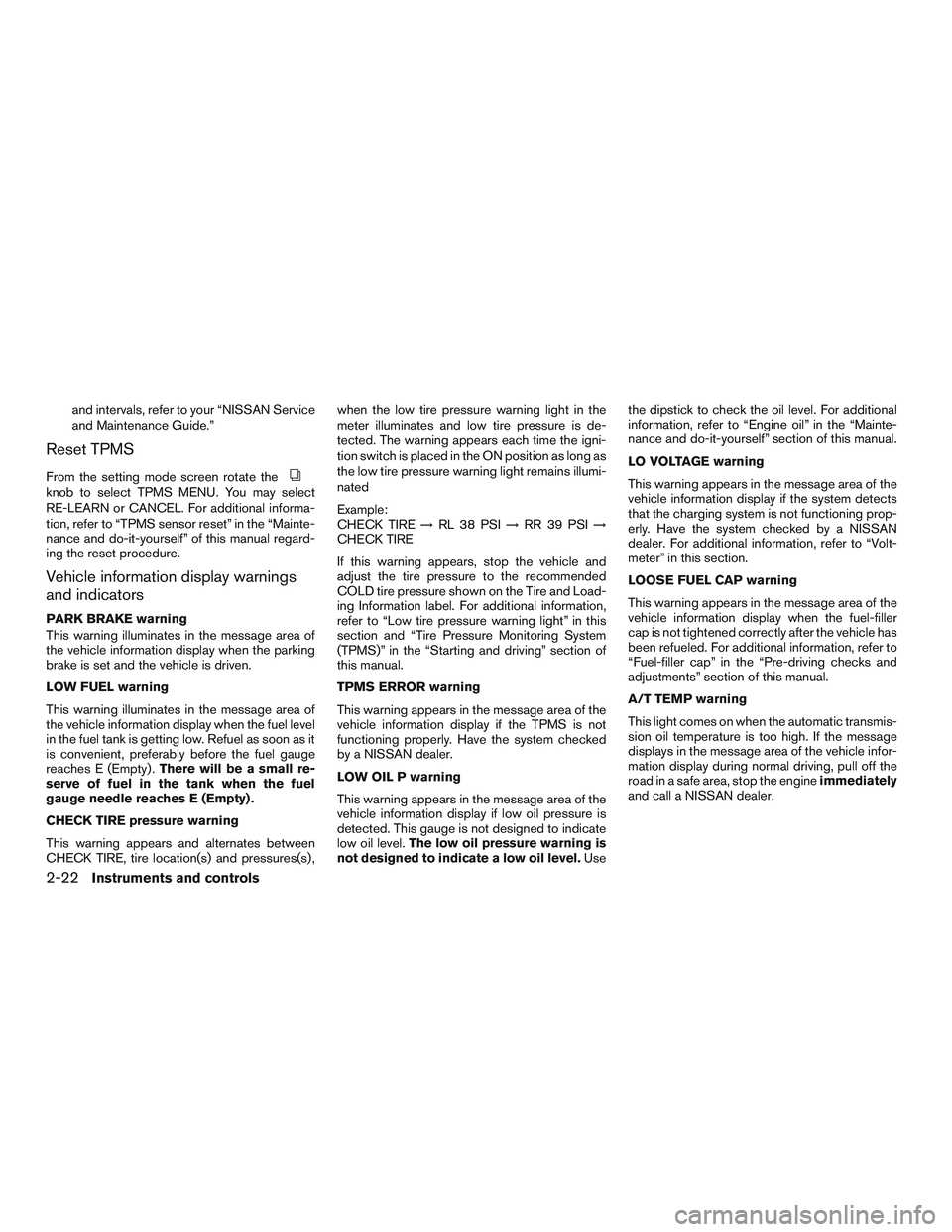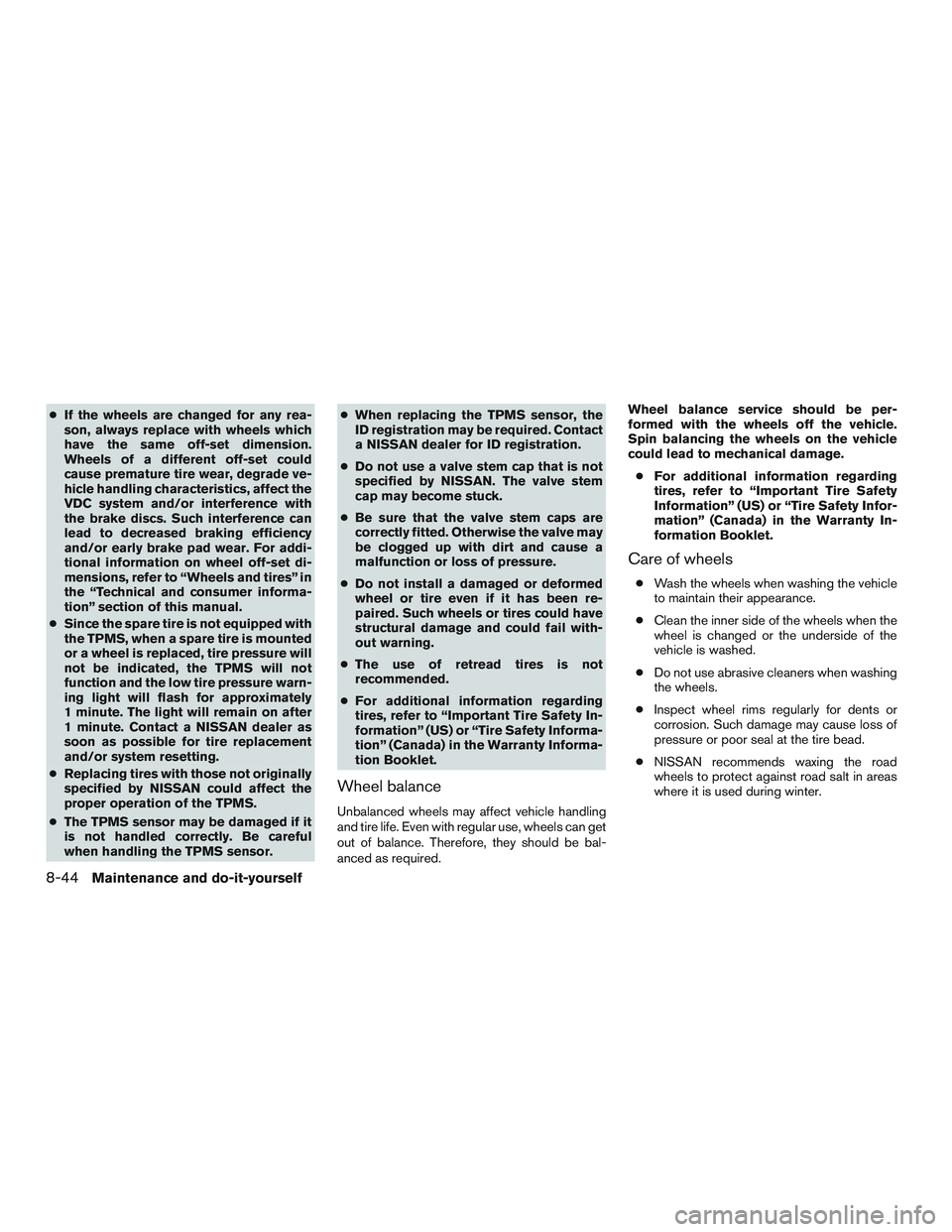2016 NISSAN NV PASSENGER VAN service reset
[x] Cancel search: service resetPage 107 of 380

and intervals, refer to your “NISSAN Service
and Maintenance Guide.”
Reset TPMS
From the setting mode screen rotate theknob to select TPMS MENU. You may select
RE-LEARN or CANCEL. For additional informa-
tion, refer to “TPMS sensor reset” in the “Mainte-
nance and do-it-yourself” of this manual regard-
ing the reset procedure.
Vehicle information display warnings
and indicators
PARK BRAKE warning
This warning illuminates in the message area of
the vehicle information display when the parking
brake is set and the vehicle is driven.
LOW FUEL warning
This warning illuminates in the message area of
the vehicle information display when the fuel level
in the fuel tank is getting low. Refuel as soon as it
is convenient, preferably before the fuel gauge
reaches E (Empty) .There will be a small re-
serve of fuel in the tank when the fuel
gauge needle reaches E (Empty) .
CHECK TIRE pressure warning
This warning appears and alternates between
CHECK TIRE, tire location(s) and pressures(s) , when the low tire pressure warning light in the
meter illuminates and low tire pressure is de-
tected. The warning appears each time the igni-
tion switch is placed in the ON position as long as
the low tire pressure warning light remains illumi-
nated
Example:
CHECK TIRE
→RL 38 PSI →RR 39 PSI →
CHECK TIRE
If this warning appears, stop the vehicle and
adjust the tire pressure to the recommended
COLD tire pressure shown on the Tire and Load-
ing Information label. For additional information,
refer to “Low tire pressure warning light” in this
section and “Tire Pressure Monitoring System
(TPMS)” in the “Starting and driving” section of
this manual.
TPMS ERROR warning
This warning appears in the message area of the
vehicle information display if the TPMS is not
functioning properly. Have the system checked
by a NISSAN dealer.
LOW OIL P warning
This warning appears in the message area of the
vehicle information display if low oil pressure is
detected. This gauge is not designed to indicate
low oil level. The low oil pressure warning is
not designed to indicate a low oil level. Usethe dipstick to check the oil level. For additional
information, refer to “Engine oil” in the “Mainte-
nance and do-it-yourself” section of this manual.
LO VOLTAGE warning
This warning appears in the message area of the
vehicle information display if the system detects
that the charging system is not functioning prop-
erly. Have the system checked by a NISSAN
dealer. For additional information, refer to “Volt-
meter” in this section.
LOOSE FUEL CAP warning
This warning appears in the message area of the
vehicle information display when the fuel-filler
cap is not tightened correctly after the vehicle has
been refueled. For additional information, refer to
“Fuel-filler cap” in the “Pre-driving checks and
adjustments” section of this manual.
A/T TEMP warning
This light comes on when the automatic transmis-
sion oil temperature is too high. If the message
displays in the message area of the vehicle infor-
mation display during normal driving, pull off the
road in a safe area, stop the engine
immediately
and call a NISSAN dealer.
2-22Instruments and controls
Page 339 of 380

●If the wheels are changed for any rea-
son, always replace with wheels which
have the same off-set dimension.
Wheels of a different off-set could
cause premature tire wear, degrade ve-
hicle handling characteristics, affect the
VDC system and/or interference with
the brake discs. Such interference can
lead to decreased braking efficiency
and/or early brake pad wear. For addi-
tional information on wheel off-set di-
mensions, refer to “Wheels and tires” in
the “Technical and consumer informa-
tion” section of this manual.
● Since the spare tire is not equipped with
the TPMS, when a spare tire is mounted
or a wheel is replaced, tire pressure will
not be indicated, the TPMS will not
function and the low tire pressure warn-
ing light will flash for approximately
1 minute. The light will remain on after
1 minute. Contact a NISSAN dealer as
soon as possible for tire replacement
and/or system resetting.
● Replacing tires with those not originally
specified by NISSAN could affect the
proper operation of the TPMS.
● The TPMS sensor may be damaged if it
is not handled correctly. Be careful
when handling the TPMS sensor. ●
When replacing the TPMS sensor, the
ID registration may be required. Contact
a NISSAN dealer for ID registration.
● Do not use a valve stem cap that is not
specified by NISSAN. The valve stem
cap may become stuck.
● Be sure that the valve stem caps are
correctly fitted. Otherwise the valve may
be clogged up with dirt and cause a
malfunction or loss of pressure.
● Do not install a damaged or deformed
wheel or tire even if it has been re-
paired. Such wheels or tires could have
structural damage and could fail with-
out warning.
● The use of retread tires is not
recommended.
● For additional information regarding
tires, refer to “Important Tire Safety In-
formation” (US) or “Tire Safety Informa-
tion” (Canada) in the Warranty Informa-
tion Booklet.
Wheel balance
Unbalanced wheels may affect vehicle handling
and tire life. Even with regular use, wheels can get
out of balance. Therefore, they should be bal-
anced as required. Wheel balance service should be per-
formed with the wheels off the vehicle.
Spin balancing the wheels on the vehicle
could lead to mechanical damage.
● For additional information regarding
tires, refer to “Important Tire Safety
Information” (US) or “Tire Safety Infor-
mation” (Canada) in the Warranty In-
formation Booklet.
Care of wheels
● Wash the wheels when washing the vehicle
to maintain their appearance.
● Clean the inner side of the wheels when the
wheel is changed or the underside of the
vehicle is washed.
● Do not use abrasive cleaners when washing
the wheels.
● Inspect wheel rims regularly for dents or
corrosion. Such damage may cause loss of
pressure or poor seal at the tire bead.
● NISSAN recommends waxing the road
wheels to protect against road salt in areas
where it is used during winter.
8-44Maintenance and do-it-yourself
Page 376 of 380

Outside mirrors.................3-18
Overheat Ifyourvehicleoverheats...........6-11
Owner’s manual order form ...........9-32
Owner’s manual/service manual order
information ....................9-32
P
Parking Parking brake operation ...........5-17
Parking/parking on hills ...........5-22
Parking brake ...................5-17
Power Power door locks ...............3-5
Power outlet ..............2-34,2-37
Power steering fluid .............8-15
Power steering system ...........5-22
Power windows ...............2-46
Power inverter switch ..............2-31
Power outlet ................2-34,2-37
Power steering ..................5-22
Power steering fluid ...............8-15
Precautions Maintenance precautions ...........8-5
Precautions on booster
seats...........1-30,1-37,1-44,1-49
Precautions on child
restraints .........1-30,1-37,1-44,1-49
Precautionsonseatbeltusage.......1-19
Precautions on supplemental restraint
system ....................1-51
Precautions when starting and driving ....5-2
Programmable features ..............4-7
Push starting ...................6-11 R
Radio AM-FM radio with compact disc (CD)
player .................4-37,4-41
Car phone or CB radio ...........4-61
FM/AM radio with compact disc (CD)
player .................4-37,4-41
FM/AM/SAT radio with compact disc (CD)
player .....................4-45
Steering wheel audio control switch ....4-58
Readiness for inspection maintenance (I/M)
test........................9-31
Rear seat air conditioner ............4-28
Rear sonar system ................5-27
Rear sonar system off switch ..........2-32
Rearview mirror .................3-17
RearView Monitor ................4-10
Rear window and outside mirror defroster
switch .......................2-26
Recommended Fluids ...............9-2
Recorders Eventdata..................9-31
Refrigerant recommendation ...........9-7
Registering a vehicle in another country ....9-10
Remote keyless entry system ........3-8,3-9
Reporting safety defects (US only) .......9-30
Reset TPMS ................2-22,8-41
S
Safety Child safety sliding door lock .........3-8
Child seat belts .....1-30,1-37,1-44,1-49 Reporting safety defects (US only)
.....9-30
Seat adjustment Front manual seat adjustment ........1-3
Front power seat adjustment .........1-4
Seat belt Child safety ..................1-27
Infants and small children ..........1-27
Injured
Person ................1-22
Largerchildren................1-28
Precautions on seat belt usage .......1-19
Pregnant women ...............1-22
Seatbeltextenders .............1-26
Seatbeltmaintenance............1-26
Seatbelts................1-19,7-5
Shoulder belt height adjustment ......1-25
Three-point type with retractor .......1-22
Seat belt extenders ...............1-26
Seatbeltwarninglight..........1-22,2-13
Seats Adjustment ...................1-2
Frontseats...................1-2
Heatedseats.................2-30
Manualfrontseatadjustment.........1-3
Seats/floor mats ..................7-4
Security indicator light ..............2-17
Security system (NISSAN Vehicle Immobilizer
System) , engine start ...........2-24,5-9
Security systems Vehicle security system ........2-23,2-23
Self-adjusting brakes ..............8-23
Service manual order form ...........9-32
Servicing air conditioner .........4-22,4-29
Setting button ...................4-7
Shifting Automatic transmission ...........5-13
Shoulder belt height adjustment ........1-25
10-5